If you need some practical information about the parts of a doorknob, you’re at the right place.
In the first section, you’ll find an illustrated overview of the main doorknob and door lock parts.
If you need more details about the individual components, you’ll find everything you need to know in the subsequent sections.
Finally, I’ll show you what and how you should measure if you’re planning to install or buy a new door lock.
Parts of a Doorknob and Door Lock – Overview Diagram
Here’s a quick overview of the different components of a doorknob:
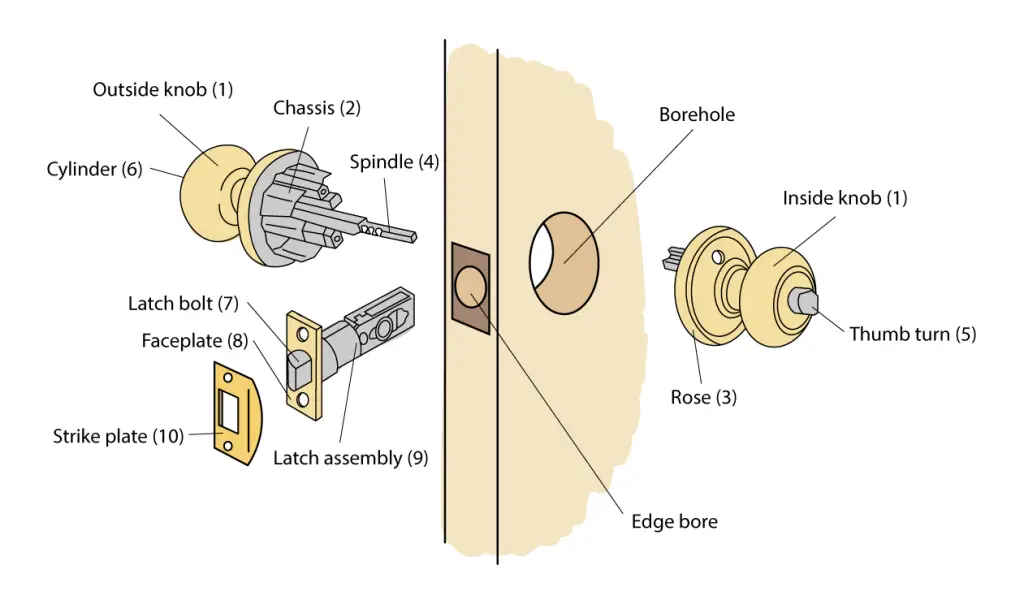
The main parts of a doorknob are the following (labeled with the corresponding number on the diagram):
- Outside and Inside Knob
- Chassis
- Rose
- Spindle
- Thumb Turn
- Cylinder
- Latch Bolt
- Faceplate
- Latch Assembly
- Strike Plate
In a nutshell, these are the most important parts of a door knob assembly. And now let’s see the details.
1. Knob or Lever
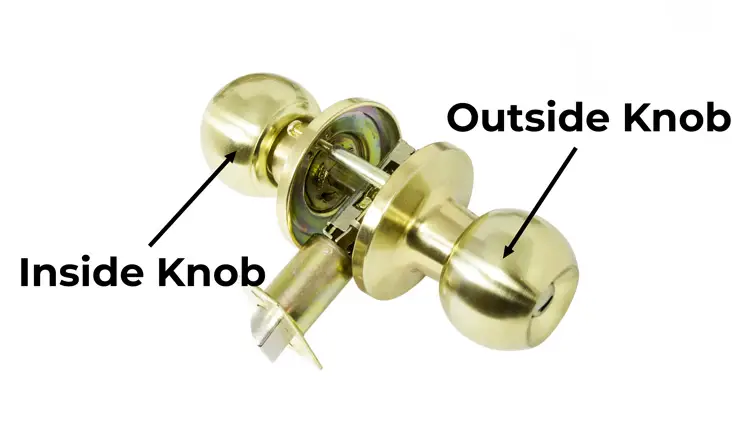
Function: The knob or lever is the handle that you turn or push down to release the latch and open the door.
What it looks like: Knobs are rounded while levers have an elongated shape. Unlike passage door knobs, entry door knobs have a cylinder and a keyhole in the middle on the outside and usually a thumb turn on the inside.
Location: The outside knob is located at the outermost end of the lock. The inside knob is in the opposite position.
2. Chassis

Function: It’s an internal part of the knob that’s responsible for protecting the locking mechanism from tampering.
What it looks like: It’s made of steel and has a round shape and an external diameter that’s slightly larger than the borehole on the door.
Location: It fits directly into and on the borehole covering and protecting the latch assembly.
3. Rose or Rosette (aka Trim)

Function: The only function of a rose is to hide the chassis and other internal parts of the door lock. It’s a decorative cover that comes in many shapes and styles.
What it looks like: Most rosettes have a rounded shape, but that’s not a rule. The rosette has a larger diameter than the borehole and it’s available in many different finishes. It’s usually made of metal.
Location: It’s located between the knob or lever and the chassis. It’s clearly visible after the installation, therefore it contributes significantly to the style and appearance of the doorknob.
4. Spindle

Function: When you turn the knob, the spindle is the part of the door knob that retracts the latch bolt. The length of the spindle is a critical parameter, as it must fit the thickness of your door. Spindle and torque blade are similar terms.
What it looks like: This is an elongated rod made of steel with a square shape. Most spindles have a width of 9/32 inches. Different types of spindles exist, such as threaded, drilled, or slotted. It’s not visible after installation.
Location: The spindle connects the outside and inside knobs with each other while passing through the latch assembly.
5. Thumb Turn
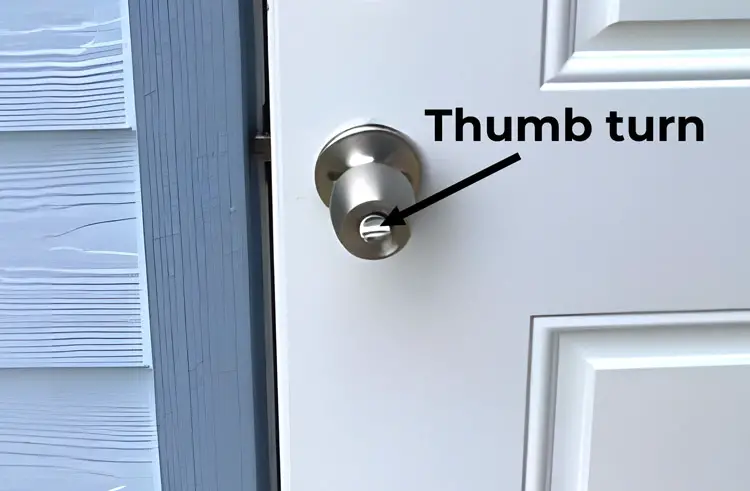
Function: The thumb turn (or lock button) is responsible for being able to lock a door from the inside without a key. Most privacy door knobs come with this feature.
What it looks like: It’s a small, round button made of steel.
Location: It’s slightly recessed at the end of the inside knob.
6. Cylinder
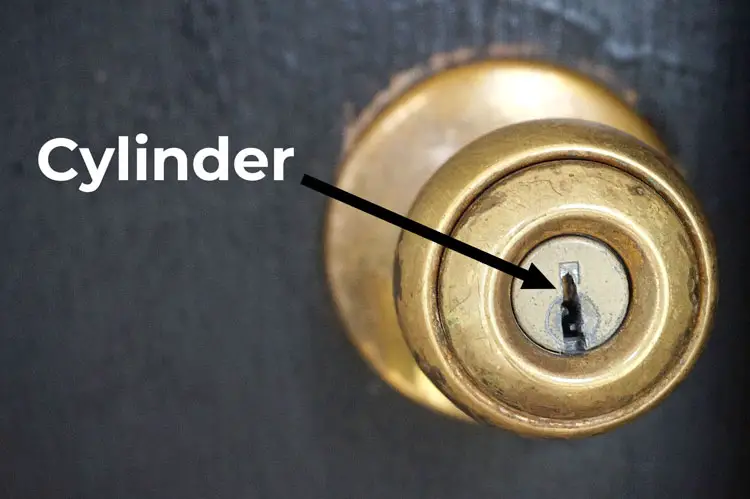
Function: The lock cylinder is the body of the lock that makes it possible to lock and unlock a door using a key (or turnkey). In a locked position it won’t allow the knob to turn and retract the bolt. It’s a key part of any door lock set.
What it looks like: The cylinder housing has a – surprise – cylindrical shape with a slot for the key, called a keyway, on the exterior end.
Location: It goes from the middle of the outside knob until it reaches the locking mechanism of the doorknob or lever.
Note: There are several types of cylinders available for doorknobs, with different lengths, shapes, and sizes, depending on the manufacturer. Before replacing an old cylinder, double-check the specifications of the new hardware. Deadbolts come with a completely different type of lock cylinder than knobs, so they’re not interchangeable with each other. If you need to lock a door without a lock, check out these simple methods.
7. Latch Bolt (Door Tongue)

Function: The job of a latch bolt (usually spring-operated) is to keep the door closed. When you turn the knob, the spindle retracts the bolt and the door can be opened. The bolt extends into the strike plate hole on the door frame.
What it looks like: A latch bolt is a D-shaped piece of metal.
Location: It’s located on the edge of the door and it’s perpendicular to the plane of the knobs.
8. Latch Faceplate (Latch Holder)
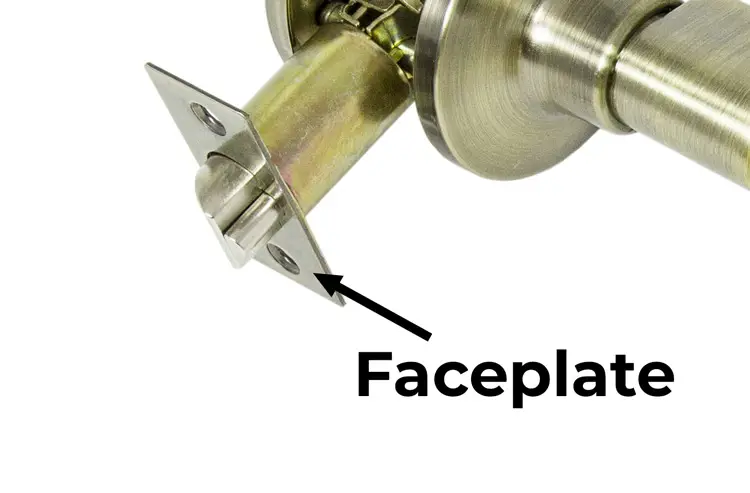
Function: The faceplate protects the body of the latch and it also secures the latch to the door.
What it looks like: It’s a metal plate that usually has a rectangular shape with rounded or right-angled corners, but it can come in many other shapes as well.
Location: It surrounds the latch bolt and it sits in a mortise on the edge of the door.
9. Latch Assembly

Function: The latch assembly controls and activates the bolt directly. It’s connected to the spindle which passes through the assembly. It basically includes the whole latch mechanism.
What it looks like: It’s a rectangular metal piece of hardware with a latch bolt and faceplate on the end.
Location: It’s located in the edge bore of the door.
10. Strike Plate
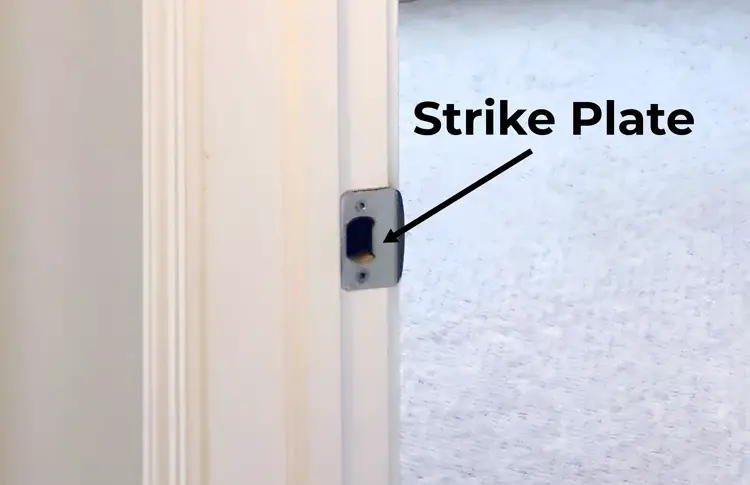
Function: The job of a strike plate or door latch plate is to reinforce and secure the mortise on the door jamb into which the bolt extends. Also, it guides and holds the bolt in place and thus keeps the door closed.
What it looks like: It’s a rectangular metal plate with a rectangular hole in the middle.
Location: On the door frame, over a mortise. For improved security, you must use at least 2½ inches long screws to mount the strike plate on the jamb. More tips on how to reinforce your front door.
Additional Doorknob and Door Lock Parts and Terms
Escutcheon
It’s a metal cover plate that is located around the keyhole. Rosette plates are often referred to as escutcheons, people sometimes use these terms interchangeably.
Deadbolt (Deadlock)
Doorknobs and deadbolts are two completely different pieces of hardware. Knobs may or may not include a cylinder and the latch bolt they contain is spring-operated. In contrast, a deadbolt always has a cylinder, and it cannot be locked and unlocked without a key (or thumb turn). Also, often it has a sturdier bolt that’s not spring-activated.
Backplate (Latch Holder)
The backplate is located between the faceplate and the latch mortise. Its main job is to secure the faceplate to the body of the latch.
Mounting Screws
These steel screws are used to mount the faceplate on the door and the strike plate on the door frame.
Knob Retainer Button
It’s a small hole or a button on the side of the knob. To remove the knob, you have to press the button or push a small piece of metal, such as a tiny screwdriver, into the hole.
Deadlocking Plunger
This piece of hardware is critical when it comes to security. Without a deadlocking plunger, the latch bolt can be easily manipulated and pushed back using a credit card or a screwdriver from the outside. Not all door knob sets come with this feature.
Related: 11 Types of Sliding Glass Door Locks
Parts of a Pin Tumbler Lock
The pin tumbler lock is the most common type of lock. To put it simply, it’s a cylinder lock that usually contains 5 or 6 pins inside.
When you insert the key, these pins change their vertical position to varying degrees and allow the core of the cylinder to turn.
Main parts of a pin tumbler lock:
- Cylinder
- Plug (the core of the cylinder)
- Pins (top and bottom)
- Springs
- Shell (the housing of the lock)
Related: 10 Effective Ways You Can Boost Apartment Door Security
Measurements You Need to Take Before Installing a Door Lock or Knob
Knowing the terminology of doorknob parts is one thing, but if you want a new door lock to fit your door, you must take some measurements.
Before buying and installing a new door lock, measure:
- the thickness of your door
- the size of the borehole
- the backset
The standard exterior door thickness is 1¾ inches, while most interior doors are 1⅜ inches thick.
The borehole (aka lockset bore or cross bore) is a large hole on the door stile where the handle set is mounted. The diameter of this hole is the size of the bore, which is typically 2⅛ inches.
Interior doors usually have only one bore, while exterior doors have two boreholes below each other. The lower one is for the doorknob and the top one is for the deadbolt.
Don’t confuse the cross borehole size with the latch bore size which is the diameter of the hole on the edge of the door. The lath bore (aka edge bore) is usually 1 inch in diameter, so it’s much smaller than the cross bore.
The backset is the distance between the center of the borehole and the edge of the door. The most common backset sizes are 2⅜ and 2¾ inches.











